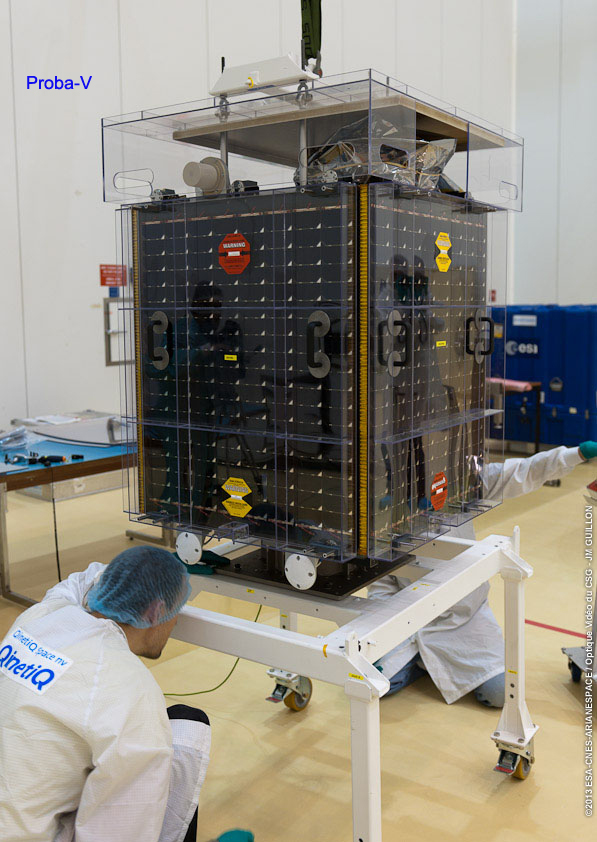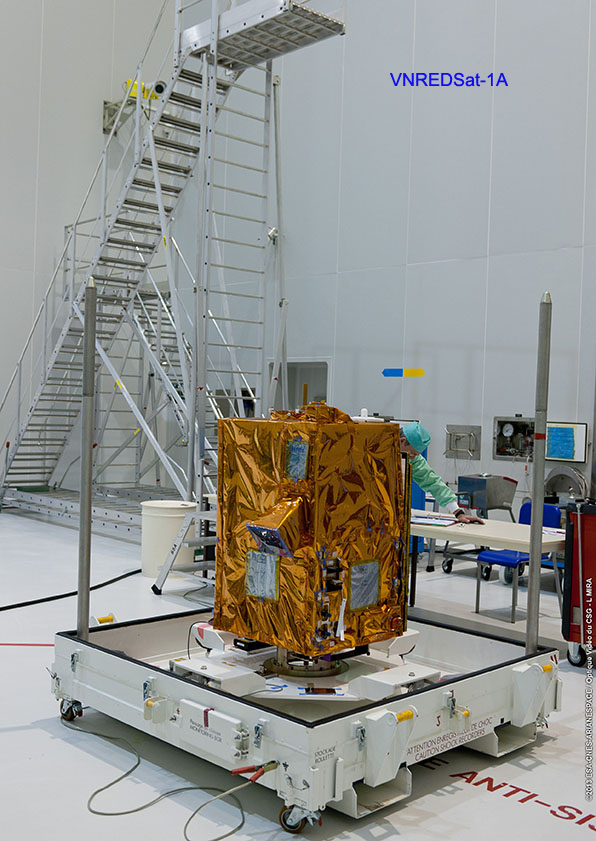.
The Proba-V and VNREDSat-1A satellites are unloaded from a 747 cargo jetliner at Félix Eboué Airport, while Vega receives its AVUM upper stage inside the mobile gantry at the Spaceport’s ZLV launch site.
.

.

.

.
Vega receives its upper stage as the next mission's two primary passengers land in French Guiana
.
Both primary payloads for Vega’s no. 2 flight have arrived at French Guiana, positioning them for integration on the light-lift launcher – which has marked another step in preparation for its mission in April from the Spaceport.
On the launch pad, the basic Vega vehicle has been “topped off” with its upper stage, called the AVUM (Attitude and Vernier Upper Module). This system performs the attitude control and axial thrust functions during the final phases of Vega’s mission profile, enabling the payload to be placed into orbit. Unlike the launcher’s three lower solid propellant stages, the AVUM uses liquid bipropellant for primary maneuvering, along with cold gas for attitude control.
The AVUM’s integration atop Vega was performed inside the ZLV launch site’s mobile gantry. This Spaceport facility originally was used for missions of the Ariane 1 and Ariane 3 vehicles, with its mobile gantry, launch pad and infrastructure updated and adapted to meet the operational requirements of Arianespace’s new lightweight vehicle.
While Vega is taking shape at the Spaceport, its Proba-V and VNREDSat-1A satellites have touched down in French Guiana aboard a chartered Boeing 747 cargo aircraft that arrived at Félix Eboué Airport near the capital city of Cayenne.
Proba-V will have an estimated mass at launch of 160 kg., and was produced by prime contractor QinetiQ Space Belgium for the European Space Agency. Operating in a Sun-synchronous polar orbit after its deployment by Vega, this satellite will monitor global vegetation growth. The spacecraft carries a newly-designed version of the Vegetation instrument previously flown on the Spot series of Earth observation satellites, which also were orbited by Arianespace.
The VNREDSat-1A co-passenger on Vega is an optical observation spacecraft built by Astrium on behalf of the Vietnam Academy of Science and Technology, and will have a mass at liftoff of approximately 120 kg. It is to support the Vietnamese government’s initiative to create an infrastructure enabling better monitoring and studies of climate change effects, while also improving predictions and actions to prevent natural disasters and optimizing the country’s management of its natural resources.
Joining them on the upcoming Vega mission is Estonia’s first satellite – the 1.33-kg. ESTCube-1 – being developed by students from Tartu University, the Estonian Aviation Academy, the Tallinn University of Technology and the University of Life Sciences, all working in conjunction with the Finnish Meteorological Institute and the German DLR space center.
ESTCube-1’s main mission is to test a novel space propulsion technology based on the electric solar wind sail concept, with this 10 x 10 x 10-cm. mini platform carrying a deployable 10-meter-long tether to be unreeled in orbit and electrically charged.
Vega’s mission in April is designated Flight VV02 in Arianespace’s numbering system, with the first “V” representing the French word for flight (“vol”), and the second letter referring to Vega. It is one of the flights scheduled in the European Space Agency’s VERTA (Vega Research and Technology Accompaniment) program, which aims to demonstrate the Vega launch system’s flexibility as well as its ability to carry multiple satellite passengers.
The four-stage Vega is tailored for small- to medium-sized satellites, complementing Arianespace’s medium-lift Soyuz and heavyweight Ariane 5 to provide a complete family of vehicles. It was developed in a European Space Agency program led by Italy’s ASI space agency and industrial prime contractor ELV SpA.
.
The two primary payloads for Vega’s second launch are readied at the Spaceport

In the photo at left, Proba-V undergoes its checkout inside the S1B clean room. At right is VNREDSat-1A, which began its processing in the S5A integration hall of the Spaceport’s S5 payload preparation building.

Payload preparations for the second Vega launch from French Guiana have commenced, with this upcoming mission’s two primary satellite passengers – VNREDSat-1A and Proba-V – now undergoing their initial checkout at the Spaceport. Vega is the lightweight member of Arianespace’s launcher family, which joins its medium-lift Soyuz and heavyweight Ariane 5 vehicles.
These pre-launch activities kicked off this month, following arrival of the two spacecraft in French Guiana. Preparations for VNREDSat-1A began inside the Spaceport’s S5A building, while Proba-V was based at the S1B clean room facility.
The VNREDSat-1A co-passenger on Vega will have a mass of approximately 120 kg. at liftoff. It was built by Astrium on behalf of the Vietnam Academy of Science and Technology, and will support the Vietnamese government’s initiative to create an infrastructure enabling better studies of climate change effects, improving predictions for natural disasters and optimizing the country’s natural resource management.
Proba-V was produced by prime contractor QinetiQ Space Belgium for the European Space Agency and will have an estimated launch mass of 160 kg. Carrying a newer version of the Vegetation imaging instrument previously flown on the Spot series of Earth observation satellites – which also were orbited by Arianespace – Proba-V will monitor global vegetation growth.
Estonia’s first satellite, the 1.33-kg. ESTCube-1, will be lofted as well on the upcoming Vega mission. Developed by students from Tartu University, the Estonian Aviation Academy, the Tallinn University of Technology and the University of Life Sciences, this small spacecraft has been evolved in conjunction with the Finnish Meteorological Institute and the German Space Center (DLR).
This upcoming mission – planned for April – is designated Flight VV02, and is one of the flights scheduled in the European Space Agency’s VERTA (Vega Research and Technology Accompaniment) program – which aims to demonstrate the Vega launch system’s flexibility as well as its ability to carry multiple satellite passengers.
.
Quelle: arianespace
6008 Views
